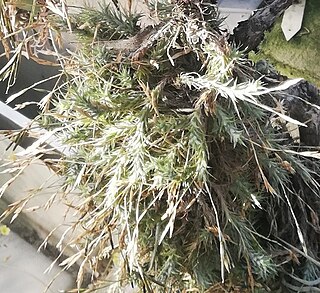
Tillandsia vernicosa is a species of flowering plant in the Bromeliaceae family. This species is native to Bolivia, Argentina and Paraguay.

Tillandsia crocata is a species in the genus Tillandsia. This species is native to Brazil, Bolivia, Argentina, Paraguay and Uruguay.

Tillandsia juncea is a species of flowering plant in the genus Tillandsia. This species is native to northern South America, Central America, Mexico and the West Indies.

Tillandsia recurvifolia is a species in the genus Tillandsia. This species is native to Bolivia, Paraguay, Uruguay, Argentina, and Brazil.

Tillandsia streptocarpa is a species of flowering plant in the Bromeliaceae family. This species is native to Bolivia, Peru, Argentina, Paraguay, and Brazil.

Tillandsia tenuifolia, the narrowleaf airplant, is a species in the genus Tillandsia. This species is widespread across much of South America and the Caribbean islands.

Tillandsia tricholepis is a plant species of flowering plant in the Bromeliaceae family. It is native to Bolivia, Paraguay, Argentina, and Brazil.

Tillandsia xiphioides is a species in the genus Tillandsia. This species is native to Bolivia, Brazil, Paraguay, Uruguay, and Argentina.

Tillandsia rhomboidea is a species of flowering plant in the family Bromeliaceae, native to Bolivia, Colombia, Costa Rica, Ecuador, Honduras, southeastern Mexico and Venezuela. It was first described by André in 1888.
Tillandsia adpressiflora is a species in the genus Tillandsia. This species is native to Bolivia, Venezuela, Colombia, Ecuador, Peru, French Guiana, and northern Brazil.

Tillandsia biflora is a species in the genus Tillandsia. This species is native to Panama, Nicaragua, Colombia, Peru, Bolivia, Costa Rica, Venezuela and Ecuador.

Tillandsia capillaris is a species in the genus Tillandsia. This species is native to southern and western South America.
Tillandsia compacta is a species of flowering plant in the genus Tillandsia. This species is native to Cuba, Hispaniola, Colombia, Bolivia, Venezuela and Ecuador.
Tillandsia confinis is a species of flowering plant in the genus Tillandsia. This species is native to Venezuela, Bolivia Colombia, Peru, northern Brazil, and Ecuador.

Tillandsia fendleri is a species of flowering plant in the genus Tillandsia. This species is native to the West Indies and South America.
Tillandsia ionochroma is a species of flowering plant in the genus Tillandsia. This species is native to Bolivia, Peru, Venezuela, and Ecuador.
Tillandsia pyramidata is a species of flowering plant in the family Bromeliaceae. It is native to Bolivia, Venezuela, Colombia, and Ecuador. Two varieties are recognized:
- Tillandsia pyramidata var. pyramidata - Venezuela, Colombia, Ecuador, Peru
- Tillandsia pyramidata var. viviparaRauh - Ecuador and Junín Province of Peru
Tillandsia rectangula is a plant species of flowering plant in the Bromeliaceae family. This species is native to Bolivia and Argentina. Tillandsia rectangula was described and the name validly published by John Gilbert Baker in 1878. Tillandsia rectangula is a species in the genus Tillandsia which contains between 713 and 777 species and belongs to the family of the Bromeliaceae. The type species of the genus is Tillandsia utriculata. The perennials prefer a sunny situation on fresh to moist soil. They tolerate temperatures only above at least 1 °C.The plants are suited for cultivation in a temperate house.
Tillandsia rubella is a species of flowering plant in the genus Tillandsia. This species is native to Bolivia, Peru, and Ecuador.

Tillandsia virescens is a plant species in the genus Tillandsia. This species is native to Argentina, Bolivia, Chile and Peru. It was first described in 1802.












